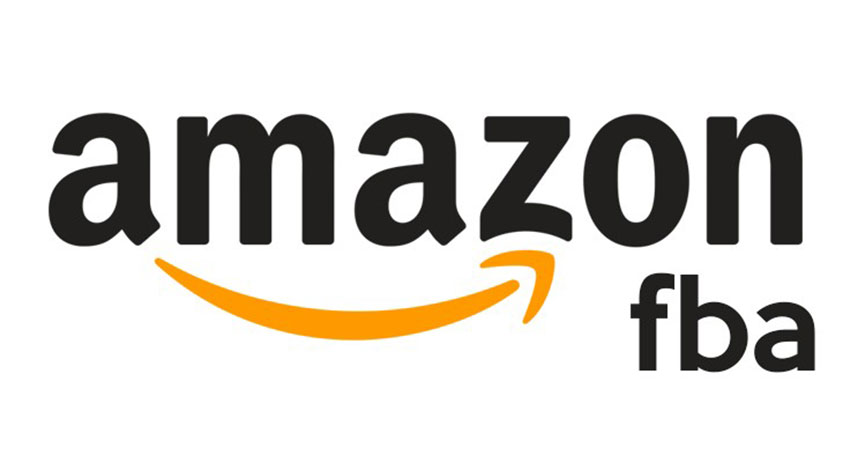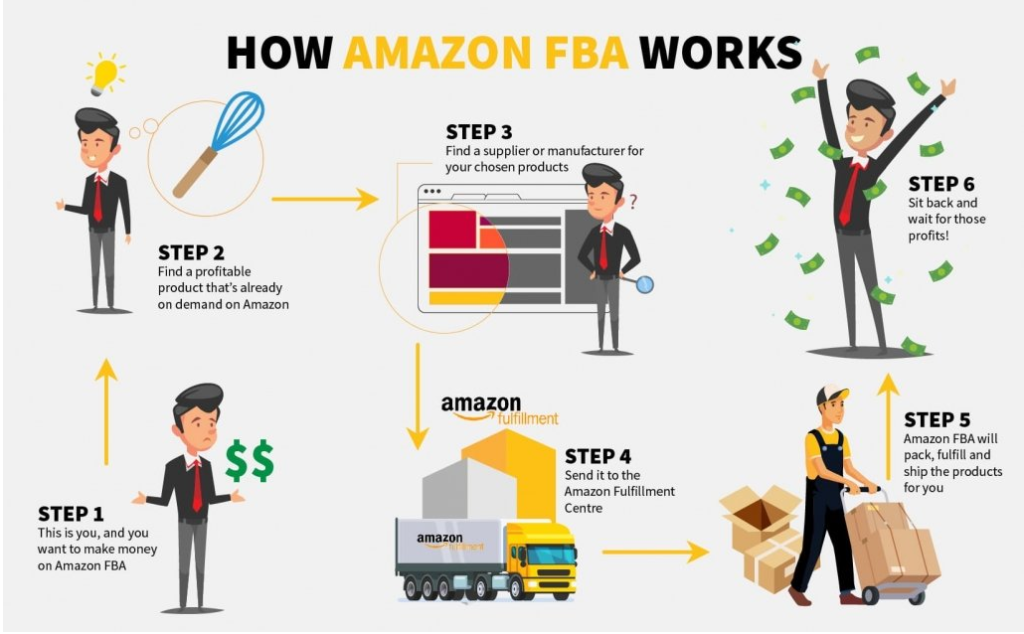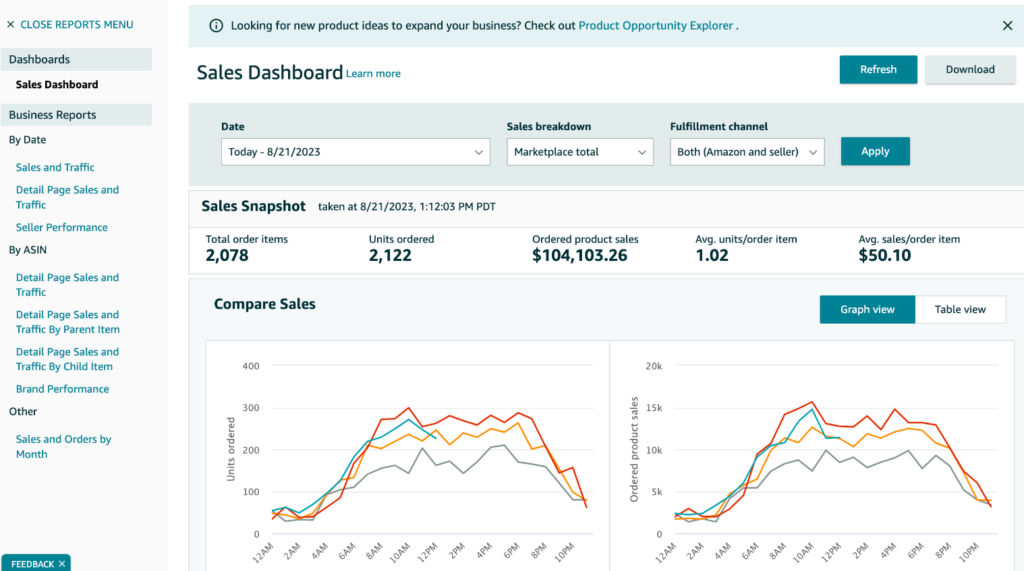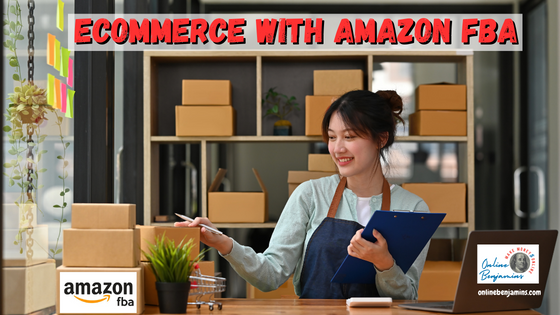If you’re exploring the world of e-commerce, you’ve undoubtedly come across the term ‘Amazon FBA.’ Short for Fulfillment by Amazon, this service has transformed the way entrepreneurs and businesses approach online retail. With this guide, we’ll take you through what makes Amazon FBA a great choice for many and how it might fit into your e-commerce strategy.
QUICK LOOK:
Amazon FBA can be a great ecommerce business model if you learn to successfully navigate the rules, procedures, and fees of the Amazon Seller Platform. To get set up you need the following:
- Business Structure – An LLC or Corporation is needed to open an Amazon FBA account
- Products and Suppliers – You need to do your research to find profitable products and supplier sources.
- Package and Deliver Products to Amazon Warehouse – check with Amazon to be sure products are correctly packaged or they won’t accept them.
- Build your product listings – Upload quality photos, product descriptions, and pricing to your account.
- Manage Your Inventory – Using pricing, Amazon analytics, and advertising to maximize profitability.
- Adapt and Adjust as Needed – Utilize Amazon Analytics to adjust and adapt your strategies.
For sellers, Amazon FBA simplifies the logistics of running an online store. By using this service, you store your products in Amazon’s fulfillment centers, and they handle storage, packaging, shipping, customer service, and returns for your orders.
They charge a fee for this service of course. But, not only does it provide convenience, but it also lends a competitive edge by offering Amazon Prime eligibility for your products, potentially increasing your visibility and sales.
Key features of Amazon FBA include its scalable infrastructure, hassle-free shipping and handling, return management, and the expansive reach of Amazon’s customer base. These benefits position Amazon FBA not just as a service but as an integrated solution for your store’s growth in the e-commerce space.

However, with opportunities come challenges. As we go through this, remember that while Amazon FBA can be a powerful tool, it requires careful planning, astute product selection, and a solid understanding of costs and competitive dynamics. It’s not a ‘set and forget’ solution—it’s dynamic, and your success will be directly related to your efforts and engagement.
How Can You Start You Get Started in Ecommerce with Amazon FBA?
Becoming a seller on Amazon can be very lucrative. It is, after all, the largest online retailer on the planet. However, it does have a pretty steep learning curve. Just navigating the rules fees and inventory requirements of the platform can be confusing.
If that’s not enough, there is the account suspensions without notice. Amazon has been notorious for suspending sellers’ accounts and holding their money, without explanation. It can take months to get reinstated all the while your store and your revenue are shut down.
To get started as a seller with Amazon FBA and have the best chance of building a successful long-term business, you need help. You need to find someone who is successful and learn from them. Or, you can explore one of the Amazon FBA automation services but be careful ( more on that later).
Otherwise, you will be going it alone and having to learn from your mistakes which can prove costly and possibly fatal to your success on Amazon. Now, I have experience with both automation services and Amazon FBA training courses. Not all have been positive.
The Good the Bad and the Ugly of Amazon FBA Automation Services
The good news is, that you can avoid some of the mistakes and pitfalls and learn from my experiences both good and bad. Let’s take a look at Amazon Automation Services, or ecommerce automation services in general.
You may have seen ads for these services. They were the hottest thing around the time of COVID. They have faded in recent years and many have gone out of business altogether taking their clients out with them.
These services claim to set up, build, secure products, and basically run your Amazon FBA store for you, In return they usually require some sort of upfront fee, and a monthly profit split and or management fee. Sounds too good to be true, doesn’t it? Guess what, for the majority of cases, it was.
I know firsthand because I tried one. Fortunately for me, I was able to see what was coming and get out before they went belly up and got most of my money back. Many others weren’t so lucky. Many of these so-called automation services turned out to be nothing more than Ponzi schemes.
Currently, I am working with another service that has been very good and very successful. Everything is upfront and out in the open and the fees are much more reasonable too. 😉 If you are interested in learning more about their services, drop me a comment at the end of this article and I will get back to you with more details.
They collected big upfront fees, farmed out the actual running of the stores to overseas freelancers, and stocked your stores with cheap products from China that often got returned. You ended up with an Amazon FBA store selling low-quality products and the same products as the rest of their clients so it became a pricing war to move inventory.
In the end, you were lucky if you made enough to pay the Amazon FBA fees. So, today we will be walking you through how to build and run your own Amazon FBA ecommerce store and have control over what happens and where your money goes.
Build Your Own Amazon FBA Business with Step-By-Step Training and Mentoring
If you are more of a do-it-yourselfer, I recommend you get some training and mentoring from someone who is successful and actively running ecommerce stores with Amazon FBA.
I have found a great Amazon FBA training course where they hold you by the hand and walk you through each step of the process to make sure you get set up and make money ASAP.
It’s called Amazon Wealth Academy, and it comes not only with over 50 video training modules, but also checklists, e-commerce software, and a supplier list of over 1500 companies where you can find products to stock and sell through your new Amazon FBA store. They have a free video you can check out if you think you might have an interest in going that route.
Amazon Wealth Academy is one the best and it will take you step-by-step through the entire process from zero to a fully functioning and profitable Amazon FBA store.
Now, if you’re a diehard do-it-yourselfer, the following guide will help you navigate the Amazon FBA startup process.
Now, I don’t know about you, but If I’m considering diving into the world of Amazon FBA, I need a roadmap to get started. So let’s talk about what I’ve found works best for navigating the Amazon FBA process. It’s not just about having great products. There’s much more to it than that.
First, setting up an Amazon seller account is your starting point. You need to decide between an Individual and a Professional account. The Professional account has a monthly fee, but it gives you access to better selling tools and is required if you plan to sell more than 40 items a month.
Next, you need to find suppliers and profitable products to sell. Choosing products isn’t guesswork. Focus on items with high demand and low competition and use tools like Jungle Scout or Helium 10 for ecommerce market analysis.
Once you have your products, You must ensure they meet Amazon’s packaging and prep requirements; otherwise, they won’t accept them. Amazon has detailed instructions on the Amazon Seller website.
Shipping items to Amazon’s fulfillment centers is the next crucial step. You can’t just send items randomly. Amazon provides specific shipping plans and labels. If you follow their instructions carefully, you’ll avoid unnecessary delays, which can be costly in both time and money.
But your job isn’t done when Amazon receives your items. Proper inventory management is key. I use Amazon’s inventory tools to monitor stock levels, sales patterns, and more. It’s essential for avoiding stockouts, which can harm your seller rating.
Use Amazon’s resources to the fullest to streamline your day-to-day operations. The Seller Central dashboard is a goldmine, filled with reports, tools, and services designed to help sellers like you and me operate efficiently, effectively, and profitably.
Amazon Wealth Academy has a full video training series that is designed to ensure you meet all of the Amazon FBA platform requirements and get your store set up and running as quickly as possible.
Tips and Best Practices for Maximizing Success on Amazon FBA
Now that you have a grasp of the Amazon FBA process, let’s enhance your strategy for success with the following tips and best practices. The Amazon marketplace is competitive, so it’s vital to STAND OUT and OPTIMIZE your approach to selling. Here’s how I’ve found success on the platform:
Product listings are your frontline. A well-crafted listing begins with professional photos and a compelling product title. Use relevant keywords, but make sure your description remains clear and persuasive. I’ve learned that bullet points are a shopper’s favorite – they’re brief and easy to scan.
Pricing is a delicate dance; set it too high, and customers may pass you by, too low, and you might compromise profitability. Regularly check competitor prices and use Amazon’s automated pricing tool to stay competitive. Remember, frequent wins, even with smaller margins, tend to scale up over time.

Advertising on Amazon can be highly effective. Sponsored Products and Amazon PPC campaigns have been game-changers for me. They enhance visibility and drive more traffic to my listings. A good rule of thumb: Invest in advertising, but keep a close eye on the returns to ensure it’s cost-effective. Otherwise, you could end up losing money.
The data Amazon FBA provides can be a gold mine. Dive into the analytics to understand sales trends and customer behavior. This will help you make informed decisions on inventory management, marketing tactics, and product development.
The key here is CONSISTENCY in monitoring and adapting based on the data. In short, find out what customers are looking for, and what they are willing to pay, then give it to them. Amazon’s Seller Central Analytics will show you what is working and what is not across the platform.
And remember, customer reviews can make or break your success on Amazon FBA. I recommend you always aim for high-quality products and exceptional customer service to encourage positive reviews. Whenever you receive negative feedback, see it as a learning opportunity and promptly address any issues.
Finally, it’s essential to recognize that while Amazon FBA can simplify many ecommerce operational procedures, it comes with a price tag. Let’s take a look at Amazon FBA’s cost structure and explore how to manage your finances to maintain profitability.
Understanding Amazon FBA Fees and Cost Structure
If you’re considering launching a business with Amazon FBA, it’s vital to grasp the cost structure involved. Amazon FBA’s fee system is multifaceted, including charges for storage, fulfillment, and optional services like advertising.
Storage fees are based on the space your inventory occupies in the fulfillment centers, and they vary seasonally, peaking during the holidays. Fulfillment fees hinge on the size and weight of your products, with a per-unit fee covering picking, packing, and shipping.
What are the total costs of using Amazon FBA?
The costs associated with Amazon FBA vary based on the products you sell and how long they remain in FBA. And, remember, these fees are subject to change so check Amazon Seller Central for the most up-to-date fee schedule. Here are the main types of fees:
- Fulfillment Fees: These are based on weight and location. Additionally, there’s a 15% sales fee for all items sold through Amazon.
- Storage Fees: These vary by time of year. From January to September, regular items cost $0.64 per cubic foot, while oversized items cost $0.43 per cubic foot. From October to December, the costs increase to $2.35 per cubic foot for regular items and $1.15 per cubic foot for oversized items.
- Inventory Placement Fees: These depend on the weight of the item and the number of FBA warehouses you ship to. Expect to pay around $0.30 + $0.10/lb. for standard items and $1.30 + $0.20/lb. for oversized items.
- Long-Term Storage Fees: If items have been in storage for 6-12 months, the fee is $11.25 per cubic foot in February and August. For items stored for 12 months or longer, it’s $22.50 per cubic foot.
It’s crucial to price your products in a way that covers these fees while remaining competitive. Researching similar products and understanding your market can aid in setting prices that work for both you and your customers.
Bear in mind, that your profit margin isn’t solely dependent on sales. Efficient inventory management to avoid long-term storage fees and strategic advertising to improve visibility can also enhance profitability.
Incorporating tools like Amazon’s FBA Revenue Calculator can provide a clearer picture of potential fees and profits. By inputting product details, the calculator estimates the fees and helps you set prices to target specific profit margins.
Planning for potential returns, considering the cost of goods, and preparing for slow seasons will support a sustainable business model. Automating processes, such as restocking and repricing, can save time and money, making your business more agile and efficient.

Through conscientious planning and smart strategy, you can use Amazon FBA to create an e-commerce business that not only manages costs effectively but also maximizes profits over time.
Remember that FBA provides fast shipping, quality customer service, and returns processing through Amazon’s extensive network. Add to that the fact that Amazon is the world’s largest retailer making it a popular choice for ecommerce sellers.
Frequently Asked Questions about Amazon FBA for Ecommerce

What is Amazon FBA?
Amazon FBA stands for Fulfillment by Amazon. It’s a service provided by Amazon that allows sellers to store their products in Amazon’s fulfillment centers. Amazon then picks, packs, ships, and provides customer service for these products.
How does Amazon FBA work?
Sellers send their products to Amazon’s fulfillment centers. When a customer places an order, Amazon picks the product from its warehouse, packs it, ships it to the customer, and handles any customer service inquiries.
–
What are the benefits of using Amazon FBA?
Amazon FBA offers benefits such as access to Amazon’s vast customer base, Prime eligibility, handling of shipping and customer service, and access to Amazon’s advanced logistics network.
How much does Amazon FBA cost?
Amazon FBA fees include storage fees, fulfillment fees (based on product size and weight), and additional fees for optional services like labeling and removal. Exact costs depend on factors such as product size, weight, and storage duration.
How do I sign up for Amazon FBA?
You can sign up for Amazon FBA through your Amazon Seller Central account. Once logged in, navigate to the “Settings” tab and select “Fulfillment by Amazon” to begin the registration process.
What products can I sell using Amazon FBA?
Amazon has specific guidelines regarding the types of products that can be sold using FBA. Generally, most new and used items in categories allowed by Amazon are eligible for FBA.
Do I need to use Amazon FBA to sell on Amazon?
No, using Amazon FBA is optional. Sellers can also fulfill orders themselves (merchant fulfillment). However, using FBA can provide access to Prime customers and streamline fulfillment processes.
How do I prepare my products for Amazon FBA?
Products must be properly packaged, labeled, and prepared according to Amazon’s guidelines. This typically involves labeling items with scannable barcodes and packaging them securely to prevent damage during transit.
How long does it take for Amazon to process FBA shipments?
Once products arrive at an Amazon fulfillment center, it usually takes 1-2 business days for them to be processed and available for sale. However, processing times can vary based on factors like the volume of incoming shipments.
Can I use Amazon FBA for international sales?
Yes, Amazon FBA offers international fulfillment services, allowing sellers to store inventory in multiple countries and fulfill orders to customers around the world. Additional fees and requirements may apply for international sales.
Insights and Takeaways of Ecommerce with Amazon FBA
To wrap up our exploration of Amazon FBA, it’s evident that this e-commerce model has its complexities, but the potential for profit and growth is substantial for those who navigate it with care and strategic planning.
KEY TAKEAWAYS:
- Starting an Amazon FBA business can certainly seem daunting at first, particularly with concerns about profitability, fees, inventory, and budget constraints. Yet, the stories of numerous successful sellers reveal that with diligent research, dedication to selecting the right products, and a customer-first approach, it’s possible to build a profitable endeavor, even on a modest budget.
- Like any business venture, challenges are inevitable. The common hurdles faced by new sellers—such as navigating the complexities of Amazon’s fees, staying competitive in pricing, and managing inventory—can often be mitigated by thorough preparation and continuous learning.
- An investment in training and mentorship will go a long way to helping your understanding of the Amazon ecosystem and adapting your strategy accordingly can pave the way to long-term success.
The journey of an Amazon FBA seller is not a sprint but a marathon. Patience, persistence, and staying informed are your best allies. Utilize the vast array of tools and resources Amazon provides to keep your business moving forward and don’t shy away from seeking advice from experienced sellers who’ve already walked the path you’re on.
As you ponder your next steps on this exciting venture, remember that the landscape of e-commerce is ever-evolving. Staying adaptable, prioritizing your customers’ needs, and maintaining a keen eye on market trends will help ensure your Amazon FBA business not only survives but thrives in the dynamic world of online retail.
More on Ecommerce
- The Impact Of AI On Content Personalization

- How To Craft Engaging Social Media Content

- The Role Of Machine Learning In Predicting Consumer Behavior

- 11 Benefits Of Launching A Merchandise Line For Your Brand

- Leveraging Ebooks For Additional Revenue Streams

- Membership Sites: Creating A Loyal Audience in 6 Steps

Wishing You Much Success in Your Amazon FBA Journey,

- onlinebenjamins.com
- thebeachangler.com
- thesinnerinthemirror.com
- my.wealthyaffiliate.com/rex10
- Facebook: Online Benjamins
- Twitter: @onlinebenjamin1
- Instagram: dotcomdinero
Rex
P.S. If you have any questions or are unsure of anything, I am here and I promise I will get back to you on all of your questions and comments. Just leave them below in the comment section and I’ll get back to you ASAP. Follow me on Twitter: @onlinebenjamin1, Instagram: dotcomdinero, and Facebook: Online Benjamins
Hi,
Thanks for stopping by and congratulations for taking the first steps to building your own online business. I’ve been in business both offline and online since 1997. I would consider it an honor to help you build your business. Father of 3, life long outdoorsman with an education in Genetics and Economics. This site is about cutting through the BS and finding the real opportunities in the online world. I look forward to working with you.




